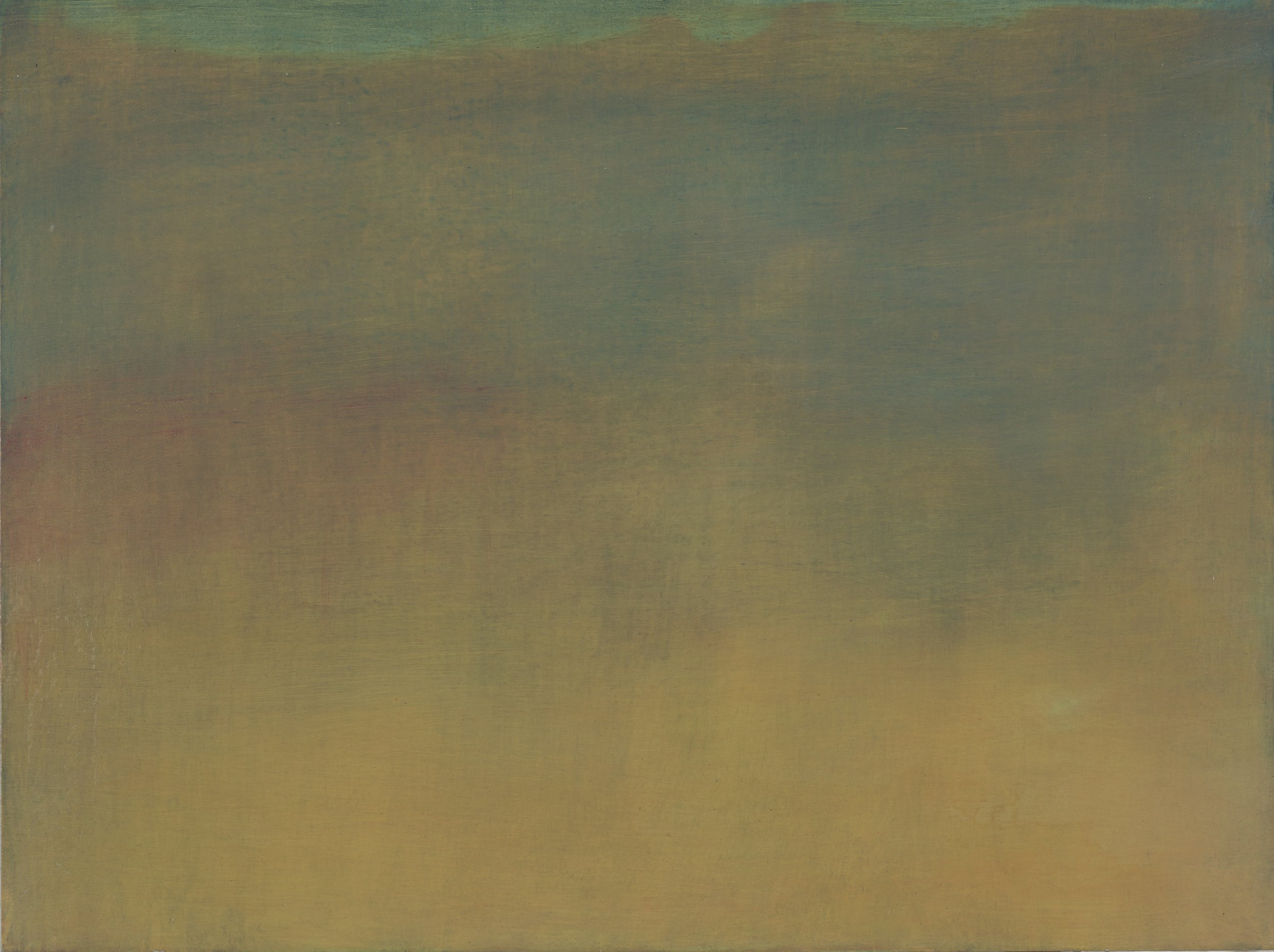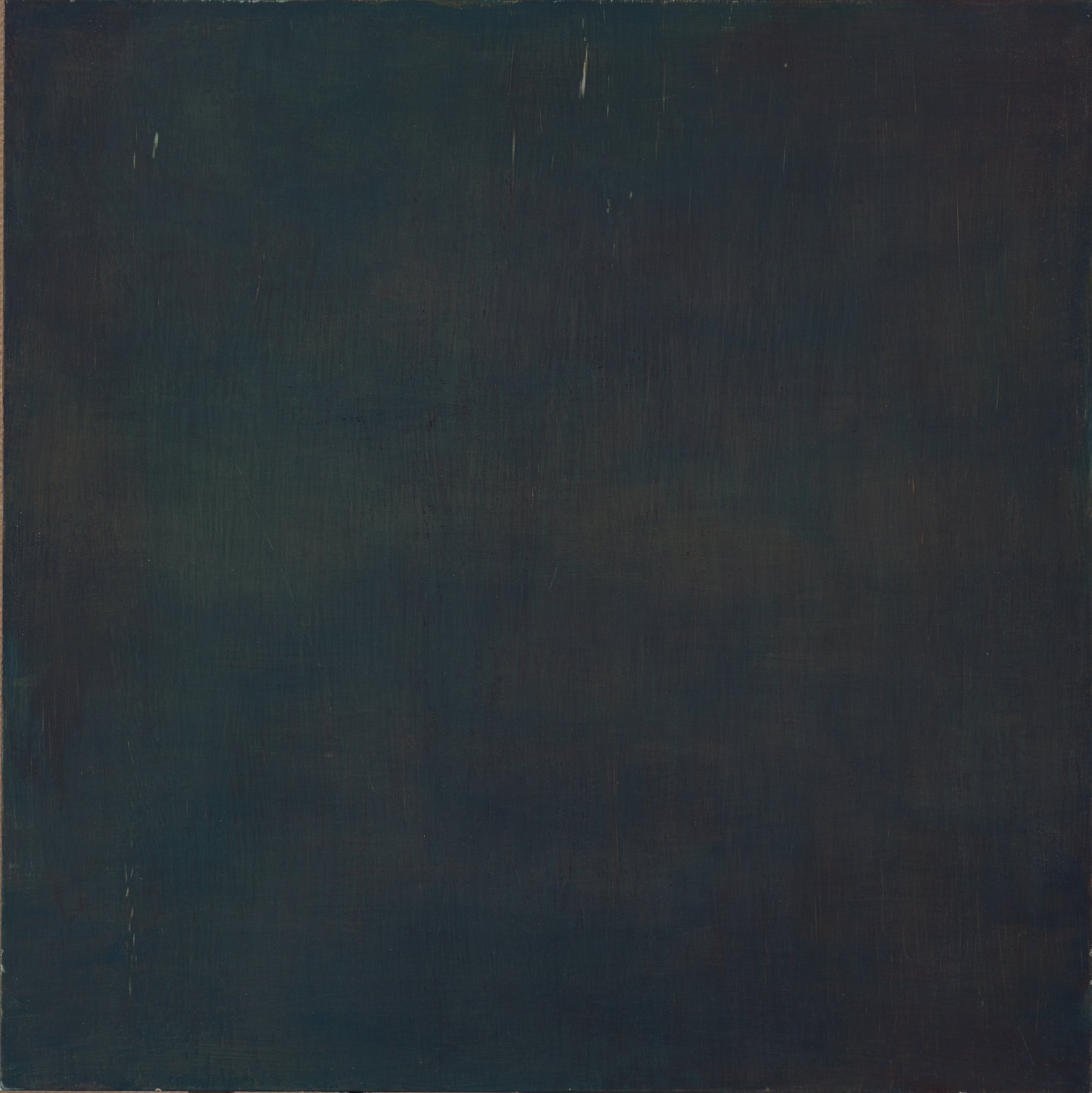Painting 18:04:02 61x45cm oil on aluminium private collection UK
Painting 19:04 61x61cm oil on aluminium private collection UK
Painting 18:14 61x61cm oil on aluminium
Painting 18:05 61x61cm oil on aluminium private collection France
Painting 18:04 61x61cm oil on aluminium private collection Germany
Painting 19:01 61x61cm oil on aluminium private collection Germany
Early on in the interminably long television series Mad Men – somewhere around 1959 – the europhile advertising executive Bertram Cooper has an abstract expressionist canvas hung in his Manhattan office. It’s a Mark Rothko, or it might be a Barnett Newman; it’s not a Joan Mitchell. Rumour of its presence spreads. A secretary breaks in to see it but once outside again cannot find the words to report the experience. Confounded by its existential magnitude, the junior creative hacks are waylaid from the business of capitalist communication before true artistic genius. Only the inhumane remain unmoved. Comically immune to its affective snares, Cooper is instead stupefied by its financial alchemy: ‘Between you and me and the lamppost’ he balks at a colleague, ‘that thing should double in value by next Christmas.’ Incomprehension before the towering force of the canvas becomes speculation on the invisible machinations of the art market: here is a new, unintended accumulative sublime.
Some ten years earlier than this fiction, Barnett Newman, writing in 1948, zeroed in on the historic aesthetic categories of ‘the beautiful’ and ‘the sublime’ to distinguish the painting of the North American avant-garde – his own work, as well as that of Rothko and Clyfford Still – from older European forms of abstract art – cubism in particular, with renaissance and ancient Greek lineage. The abstract expressionists, Newman argued in ‘The Sublime is Now’, had set aside ideas of beauty to seek the exaltation of sublime subjects and absolute emotions, and in doing so freed themselves of ‘the impediments of memory, association, nostalgia, legend, myth, or what have you, that have been the devices of Western European painting’.[1]
No need for the obsolete props of an outmoded and antiquated legend: mountainous landscapes with remote and misted peaks; tortuous, torrent-filled ravines; still and hazy scenes, dissolved in intense sunlight or swimming in aqueous mists; travellers struggling to traverse mountains, to negotiate wild and wind-swept passes; sailors embroiled in life-threatening storms at sea. No need for the philosopher Edmund Burke’s fantastic compendium of sublime subjects outlined in A Philosophical Enquiry into the Origin of Our Ideas of the Sublime and the Beautiful (1757). How could it be, Newman asks, that he and his contemporaries could be making an art of the sublime without the divine faith that built Europe’s greatest cathedrals? ‘Instead of making cathedrals out of Christ, man, or “life”,’ he concludes his essay:
we are making it out of ourselves, out of our own feelings. The image we produce is the self-evident one of revelation, real and concrete, that can be understood by anyone who will look at it without the nostalgic glasses of history.
This turn inwards, away from the external stimulus of the sublime, fortifying the private individual, occasioned by paint alone, is testament to romanticism’s disturbing legacy. While the sublime never seems to vanish, its operations change. So what is this ‘vanishing sublime’ the painter Siemon Scamell-Katz alludes to in his body of work produced over the past decade and gathered for this exhibition at Black Barn?
It is, Scamell-Katz has explained, the German romantic ‘art religion’ of the sublime that appeals to him. Friedrich’s orant figures on the brink of some elemental and mystical experience in the greatness of nature. Damp-feet merchants annihilated at the sea’s littorals. The wanderers at the precipices of nothingness. Stiffkey’s saltmarshes are for Scamell-Katz what the Baltic shoreline was for Friedrich: a perceptually mellifluous place of wavering scale. Like Friedrich, J.M.W. Turner, another of Scamell-Katz’s references, rent a quasi-religious intensity to shimmering views where the natural and the supernatural run. If Angel Standing in the Sun (1846) visualises a thin place of holy awe between heaven and earth, Rain, Storm, and Speed – The Great Western Railway, exhibited two years earlier, signals the terrestrial dread of the industrial era: emerging through the mingling, melting skies is a secular, modern sublime that presages carboniferous extinction.
Wordworth’s The Prelude (1850) – alongside the contemporary verse of North American poet Michael Dickman – is an important source Scamell-Katz responds to in his paintings. Rich with the conscious application of Burke’s devices, The Prelude applies a textured array of conflicting forces: the prescient and timeless; the dynamic and the formless; the frighteningly proximate and the distant; the still and the giddy. And the most vital characteristic of all, the perpetual oscillation between wonderment and dread, calm and terror. Dynamic, perceptually wavering, this is, according to Burke, the very essence of ‘sublime’ apprehension:
… if pain is not carried to violence, and the terror is not conversant around the present destruction of the person, as the emotions clear the parts of a troublesome encumbrance, they are capable of producing delight; not pleasure, but a sort of delightful horror; a sort of tranquility tinged with terror.[2]
According to Burke, the experience of ‘beauty’ remains in the realm of human cognitive comprehension, conferring a sense of well-being on the subject, whereas the sublime, occupying a strange place between aesthetic experience and cognition, seems to reach for a state beyond the realm of immediate comprehension. For the philosopher Immanuel Kant the experience of beauty is an experience of the measurable, while sublimity is an experience of magnitude without limit. For Kant, measurement is aligned to form:
The beautiful in nature is a question of the form of the object, and this consists in limitation, whereas the sublime is to be found in an object even devoid of form, so far as it immediately involves, or else by its presence provokes, a representation of limitlessness, yet with a super-added thought of its totality.[3]
Whereas the form of the beautiful resides in limitation, the sublime challenges the act of judgment itself by suggesting limitlessness. Reason is forced to confront its incapacity to deal rationally with the infinite, threatening the mind’s sense of its own capabilities. But as the critic Sianne Ngai reminds us, this pleasure is predicated on the ultimate ability of human reason as a superior faculty.[4] Masochistic, displeasure is integrated with pleasure that issues precisely from a feeling of security and control. Uttering the safe word is akin to looking away.
By dramatising the limit within limitlessness, the sublime is always concerned with the part in relation to, as Kant put it, a ‘super-added thought of its totality’. Temporary encounters with landscapes may be, as Scamell-Katz has suggested, so many instances of the vanishing sublime: these paintings are sensuous abstractions of encounters, traces of optical intensities. But there is something wilfully impersonal about these paintings. The colour fields on aluminium panels – serial in the language of minimalism – minimalism subscribed to an industrial aesthetic to counter the impression that the works were charged with personal or subjective experience – hold representation in abeyance.[5] What at a distance appears as blankness is on scrutiny a luminous opacity.
Starting with an enamel ground, typically of dark Sienna, subsequent skeins of oil glaze are added and removed, either brushed and ragged while wet, or sanded once dried. Sanding, Scamell-Katz has explained, is very often about removing evidence of application – concealing labour – while the final layer retains brush marks. Process-based, worked up from sketches or responding to texts, each panel is an accretion of durations, sometimes of up to a year. They amount to, as Scamell-Katz puts it, ‘merely the temporal depiction of sensation’. Blushes of colour appear to be held in the suspension material and on the surface. The ponderous depth this creates on the super-flat aluminium surface is activated by the viewer’s position in changing conditions. Its transitory effects make it less of a thing than an event to behold.
By removing iconography and symbols, by removing textual titles, perception becomes an event in the gallery, recalling something Bridget Riley once claimed for her work: ‘I want the disturbance or “event” to arise naturally, in visual terms, out of the inherent energies and characteristics of the elements which I use’.[6] Scamell-Katz’s desire to empty out the works of significance is informed by his research on visual perception and the realisation that estimation and approximation is central to seeing. The eye, he explains, continuously jumps and stops in saccadic movements. A fixation may last only 500 milliseconds. While the foveal-attention is a patch the size of a thumbnail it moderates what is at peripheries of vision. Seeing, understood as the surest of senses, is characterised by not-knowing. Perceptual gaps are filled at preconscious, habitualised levels informed by our hyper-saturated capitalist image-world. Every picture problematises the relation of the part to the totality.
In his essay ‘Of the Truth of Skies’, published in Modern Painters Vol.1 in 1843, John Ruskin surveys a micro-history of skies in society and art in order to feel the revolutionary shock of Turner’s ‘breaking, mingling, melting’ skies.[7] Really look at the sky, Ruskin implores. Even the pure blue of a serene sky is not a flat dead colour. It quivers in variety and fulness – in it you see or imagine short falling spots of deceiving light, dim shades, faint veiled vestiges of dark vapour. What Ruskin describes when he implores us to really look at the sky is the instability of perception. For Ruskin the genius of Turner is that with him we are inside it; Turner shows how the atmosphere affects our perception of landscape. This is later elaborated by the art historian Jonathan Crary when he writes of Turner: ‘[H]is painting of the late 1830s and 1840s signals the irrevocable loss of a fixed source of light, the dissolution of a cone of light rays, and the collapse of the distance separating an observer from the site of optical experience’.[8] Turner’s late work announces a new status of the artist-observer, distinct from the scientific-observer.
A vanishing sublime might also be the marker of the end of otherness. No thing beyond the limits of comprehension. Life disenchanted. Or looked at differently, it might point to the profound impersonality of these scenes that open onto a contemporary form of the sublime that Siann Ngai has called, folding ‘sublime’ into ‘stupor’, ‘stuplimity’. If the classical sublime is predicated on ultimate feelings of security, we no longer can take the persistence of nature for granted in this age of extinction. Nature in Scamell-Katz’s paintings fills us with dread because there is no safe word. We cannot look away.
– Jonathan P. Watts is a contemporary art critic and curator based in Norwich, UK
[1] Barnett Newman, ‘The Sublime is Now’, Tiger’s Eye, vol.1, no.6, December 1948.
[2] Edmund Burke, A Philosophical Enquiry into the Origin of Our Ideas of the Sublime and Beautiful, Oxford World’s Classics, 2008
[3] Immanuel Kant, Critique of the Power of Judgment, Cambridge University Press, 2002.
[4] Sianne Ngai, Ugly Feelings, Harvard University Press, 2007.
[5] Isabelle Graw, The Love of Painting: Genealogy of a Success Medium, Sternberg Press, 2018.
[6] Bridget Riley, ‘Perception is the Medium’, ArtNews, October 1965.
[7] John Ruskin, Selected Writings, Oxford World’s Classics, 2009.
[8] Jonathan Crary, Techniques of the Observer: On Vision and Modernity in the Nineteenth Century, MIT Press, 1990.






